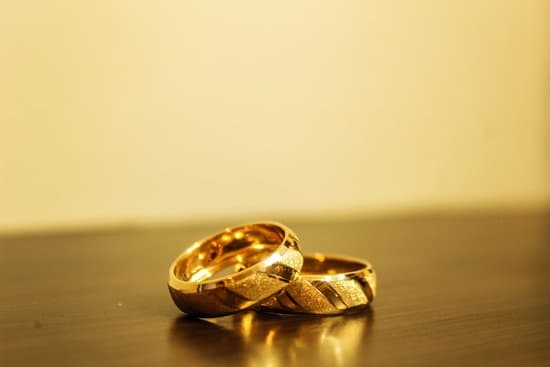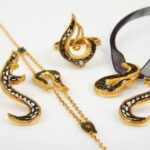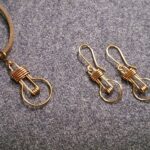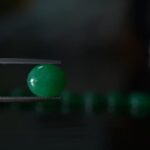Are you able to tell fine jewelry from costume? Knowing how to differentiate between these two types of jewelry is crucial for anyone who appreciates quality and seeks to make informed purchases. The ability to discern the difference ensures that you invest in pieces that hold their value and stand the test of time, rather than being misled by imitations or lower-quality items.
Fine jewelry is crafted with precious metals like gold, silver, and platinum, as well as high-quality gemstones such as diamonds, rubies, and sapphires. These pieces are meticulously made by skilled artisans using superior craftsmanship, resulting in durable and stunning creations that can be cherished for generations.
On the other hand, costume jewelry typically uses non-precious metals like brass or copper, along with synthetic or low-grade gemstones. Manufactured in bulk through cost-effective methods, costume jewelry may lack the durability and timeless appeal associated with fine jewelry. Understanding the distinctions between these categories empowers consumers to make informed decisions about their purchases and collections.
What Is Fine Jewelry
Characteristics of Fine Jewelry
Fine jewelry is typically characterized by its high-quality materials, such as precious metals like gold, silver, and platinum, as well as precious gemstones like diamonds, rubies, emeralds, and sapphires. These materials are chosen for their durability and value, making fine jewelry pieces long-lasting and coveted.
Materials Used in Fine Jewelry
In addition to precious metals and gemstones, fine jewelry may also include other high-quality materials such as pearls, jade, or opals. These materials are carefully selected for their beauty and uniqueness. The use of these valuable materials sets fine jewelry apart from costume jewelry that often relies on less expensive alternatives or imitations.
Craftsmanship in Fine Jewelry
Another defining characteristic of fine jewelry is the level of craftsmanship involved in its creation. Fine jewelry pieces are often handcrafted by skilled artisans who pay close attention to detail and precision. This meticulous craftsmanship results in stunning and intricately designed pieces that showcase the expertise of the jeweler.
By understanding these characteristics, materials, and craftsmanship associated with fine jewelry, individuals can better discern between genuine fine jewelry and costume imitations. Whether purchasing a piece for oneself or a loved one, knowing how to tell fine jewelry from costume ensures that one makes informed and valuable investments in their collection.
What Is Costume Jewelry
Costume jewelry, also known as fashion jewelry or imitation jewelry, is a type of jewelry that is made from less expensive materials and is often mass-produced. Unlike fine jewelry, which is crafted from precious metals and gemstones, costume jewelry tends to be made from materials like base metals, glass, plastic, and synthetic gemstones. These less costly materials allow for the creation of trendy and affordable pieces that can be worn to accessorize different outfits without breaking the bank.
In addition to the materials used, the manufacturing processes for costume jewelry are typically more industrialized and standardized compared to those used in creating fine jewelry. This means that costume jewelry may be produced in larger quantities using machinery and assembly line techniques, resulting in pieces that are more uniform in appearance. While this can make costume jewelry more accessible and budget-friendly, it also means that the craftsmanship and individuality found in fine jewelry may be lacking.
Another defining characteristic of costume jewelry is its focus on fashion trends and seasonal styles. Because of its affordability and versatility, costume jewelry often reflects current fashion trends and can quickly adapt to changes in style, making it a popular choice for those looking to accessorize their outfits with on-trend pieces without investing too much money.
Key Differences Between Fine Jewelry and Costume Jewelry
When trying to distinguish between fine jewelry and costume jewelry, there are several key differences that can help you determine the quality and value of a piece. One of the most significant disparities between the two is the materials used in their construction.
Fine jewelry is typically crafted from precious metals such as gold, silver, or platinum, and often features gemstones like diamonds, rubies, sapphires, and emeralds. On the other hand, costume jewelry is made from more affordable materials like brass, copper, or nickel, and may include synthetic stones or plastic embellishments.
Another important factor to consider when identifying fine jewelry versus costume jewelry is the craftsmanship and manufacturing processes involved in creating each type of piece. Fine jewelry is meticulously crafted by skilled artisans using traditional techniques that require precision and attention to detail.
This level of craftsmanship results in durable, long-lasting pieces that can be passed down through generations. In contrast, costume jewelry is mass-produced using machinery and often lacks the intricate detailing and high-quality workmanship found in fine jewelry.
In addition to materials and craftsmanship, another key difference between fine jewelry and costume jewelry lies in their overall value. Fine jewelry holds intrinsic value due to its use of precious metals and genuine gemstones, making it a worthwhile investment for many individuals.
Conversely, costume jewelry is considered more disposable and doesn’t retain its value over time as it’s made from less expensive materials. Understanding these distinctions can be essential when making purchasing decisions or assessing the worth of your personal collection.
| Feature | Fine Jewelry | Costume Jewelry |
|---|---|---|
| Materials | Precious metals & gemstones | Affordable metals & synthetic stones |
| Craftsmanship | Handcrafted with attention to detail | Mass-produced with less detail |
| Value | Intrinsic due to precious materials | Lacks long-term value |
How to Spot Fine Jewelry
When it comes to shopping for jewelry, being able to differentiate between fine jewelry and costume jewelry is crucial. Fine jewelry is an investment that holds value over time, while costume jewelry is often more affordable and trendy. Knowing how to spot fine jewelry can help shoppers make informed decisions and ensure they are getting the quality they desire. Here are some tips and tricks for identifying fine jewelry when shopping or examining pieces.
Pay Attention to Hallmarks
One of the easiest ways to identify fine jewelry is by looking for hallmarks on the piece. These small stamps or engravings indicate the metal content of the piece, as well as the manufacturer or designer. For example, a “925” hallmark signifies sterling silver, while “14K” or “18K” indicates gold content. Hallmarks can also provide insight into where the piece was made and may include symbols or letters representing the origin.
Examine the Quality of Gemstones
Fine jewelry often features high-quality gemstones that are carefully selected and expertly set. When examining a piece, take note of the gemstone’s clarity, color, and cut. Fine jewelry will typically showcase gemstones with vibrant colors, minimal inclusions, and precision cuts. Additionally, genuine gemstones such as diamonds, rubies, sapphires, and emeralds are commonly found in fine jewelry due to their durability and rarity.
Inspect the Workmanship
The craftsmanship of a piece can indicate whether it is fine jewelry or costume jewelry. Fine jewelry is meticulously crafted with attention to detail, smooth edges, and secure settings for gemstones. Pay close attention to clasps, prongs, and soldering joints to assess the quality of workmanship. Additionally, examine any engravings or embellishments on the piece for signs of handcrafted artistry. Quality fine jewelry will exhibit superior construction that reflects the expertise of skilled artisans.
How to Spot Costume Jewelry
When it comes to purchasing jewelry, it’s important to be able to differentiate between fine jewelry and costume jewelry. Costume jewelry is often made with less valuable materials and doesn’t require the same level of craftsmanship as fine jewelry. Being able to spot costume jewelry can save you from overpaying for a piece that isn’t worth its price tag.
Signs That Indicate a Piece of Jewelry Is Costume Rather Than Fine
- Materials: One of the easiest ways to tell if a piece of jewelry is costume is by examining the materials used. Costume jewelry is often made with base metals like brass or copper, and may be plated with gold or silver. Fine jewelry, on the other hand, is crafted from precious metals like gold, platinum, or sterling silver, and may feature genuine gemstones.
- Craftsmanship: Another sign of costume jewelry is the level of craftsmanship. Fine jewelry requires intricate detailing and precision in its construction, while costume jewelry may have visible seams, rough edges, or uneven stones. Take a close look at the piece to assess the quality of its construction.
- Brand and Markings: Many fine jewelry pieces are stamped or engraved with markings that indicate their metal content and authenticity. Look for markings such as “14k” or “925” on rings, necklaces, and bracelets. If a piece has no such markings or features a generic brand name, it’s likely to be costume rather than fine.
By understanding these signs that indicate a piece of jewelry is costume rather than fine, you can make informed decisions when shopping for new additions to your collection. Whether you’re looking for an investment piece or simply want to ensure quality in your accessories, being able to tell fine jewelry from costume is an essential skill for any jewelry enthusiast.
Importance of Knowing the Difference
When it comes to jewelry, being able to tell the difference between fine and costume pieces is crucial for several reasons. Understanding the distinctions between these two types of jewelry can help consumers make informed decisions when making purchases, as well as properly care for and maintain their jewelry collections. Furthermore, being able to identify fine jewelry from costume pieces can also impact the perceived value and significance of a particular piece.
Importance of Knowing the Difference
- Value: Fine jewelry often holds significant monetary value due to the quality of materials used, such as precious metals and gemstones. Being able to accurately identify fine jewelry can prevent individuals from overpaying for counterfeit or imitation pieces.
- Quality: The craftsmanship and attention to detail found in fine jewelry sets it apart from costume jewelry. Understanding the difference allows consumers to appreciate the superior quality of fine pieces and make informed decisions about their purchases.
- Significance: Fine jewelry is often passed down through generations and holds sentimental value for many individuals. Recognizing fine jewelry allows people to properly care for and preserve these meaningful heirlooms.
In addition to these factors, knowing how to tell fine jewelry from costume can also impact personal style choices and overall aesthetic preferences. By understanding the differences between these two categories, individuals are empowered to choose pieces that align with their personal tastes, lifestyle, and budget.
Ultimately, having a keen eye for distinguishing between fine and costume jewelry not only contributes to making sound investments but also adds depth and knowledge to one’s appreciation for this form of artistry. Whether it’s for personal enjoyment or investment purposes, being able to tell the difference is an invaluable skill that enhances one’s overall experience with jewelry.
Conclusion
In conclusion, being able to differentiate between fine jewelry and costume jewelry is crucial for anyone who values quality and authenticity in their jewelry pieces. Understanding the characteristics, materials, and craftsmanship of both types of jewelry empowers consumers to make informed purchasing decisions and build a collection they can be proud of. By recognizing the key differences between fine and costume jewelry, individuals can ensure that they are investing in pieces that hold value and significance.
When it comes to spotting fine jewelry, paying attention to details such as hallmarks, quality of gemstones and precious metals, and reputable brands or designers can help discern the authenticity of a piece. On the other hand, signs of lower quality materials, mass production processes, and lack of intricate design can indicate that a piece is costume jewelry rather than fine. Knowing these distinctions allows individuals to confidently assess the value and worth of the jewelry they are considering purchasing.
Frequently Asked Questions
How Can You Tell the Difference Between Real Jewelry and Costume?
The key difference between real jewelry and costume jewelry lies in the materials used. Real jewelry is typically made from precious metals like gold, silver, or platinum, and often features genuine gemstones.
On the other hand, costume jewelry is crafted from non-precious metals like brass or copper, and may use synthetic or imitation stones to mimic the look of real gems.
How Do You Differentiate Fine Jewelry With Fashion Costume Jewelry?
When distinguishing fine jewelry from fashion costume jewelry, it’s important to consider the craftsmanship and materials. Fine jewelry is usually made with high-quality metals and genuine gemstones, while fashion costume jewelry tends to use lower quality materials like base metals and faux stones.
Additionally, fine jewelry often carries hallmark stamps indicating its metal content, which is not commonly found in fashion costume jewelry.
How Can You Tell the Quality of Costume Jewelry?
Evaluating the quality of costume jewelry can be done by examining factors such as the finish of the metal, the precision of any stone settings, and the overall weight and feel of the piece. High-quality costume jewelry will have a polished finish with no discoloration or tarnishing.
The stone settings should be secure and neatly done. A well-made piece of costume jewelry will also have some weight to it, conveying a sense of durability and sturdiness.

Welcome to my jewelry blog! My name is Sarah and I am the owner of this blog.
I love making jewelry and sharing my creations with others.
So whether you’re someone who loves wearing jewelry yourself or simply enjoys learning about it, be sure to check out my blog for insightful posts on everything related to this exciting topic!





